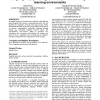Free Online Productivity Tools
i2Speak
i2Symbol
i2OCR
iTex2Img
iWeb2Print
iWeb2Shot
i2Type
iPdf2Split
iPdf2Merge
i2Bopomofo
i2Arabic
i2Style
i2Image
i2PDF
iLatex2Rtf
Sci2ools
ACMIDC
2009
2009
Designing for physical-digital correspondence in tangible learning environments
In tangible learning environments the potential to exploit different physical-digital links increases representational power but also broadens the complexity of design. This paper presents studies that illustrate the effect of physical correspondence design choices on learners' interpretations, particularly regarding meaning making and conceptual mappings between objects and representations, and learners' ability to generalize. Preconceptions and associations with familiar real settings were found to have a significant level of interference in children's perception, interpretation and comprehension of the concepts. Categories and Subject Descriptors H5.2. Information interfaces and presentation: User interfaces. K.3.m Computers and education: Miscellaneous. General Terms Human Factors Keywords Tangible, interactive surfaces, physical correspondence, children, design, learning.
ACMIDC 2009 | Human Computer Interaction | Increases Representational Power | Physical Correspondence | Physical Correspondence Design |
Related Content
| Added | 15 Aug 2010 |
| Updated | 15 Aug 2010 |
| Type | Conference |
| Year | 2009 |
| Where | ACMIDC |
| Authors | Sara Price, Taciana Pontual Falcão |
Comments (0)

